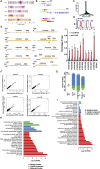FAR-RED ELONGATED HYPOCOTYL3 activates SEPALLATA2 but inhibits CLAVATA3 to regulate meristem determinacy and maintenance in Arabidopsis
- PMID: 27469166
- PMCID: PMC4995929
- DOI: 10.1073/pnas.1602960113
FAR-RED ELONGATED HYPOCOTYL3 activates SEPALLATA2 but inhibits CLAVATA3 to regulate meristem determinacy and maintenance in Arabidopsis
Abstract
Plant meristems are responsible for the generation of all plant tissues and organs. Here we show that the transcription factor (TF) FAR-RED ELONGATED HYPOCOTYL3 (FHY3) plays an important role in both floral meristem (FM) determinacy and shoot apical meristem maintenance in Arabidopsis, in addition to its well-known multifaceted roles in plant growth and development during the vegetative stage. Through genetic analyses, we show that WUSCHEL (WUS) and CLAVATA3 (CLV3), two central players in the establishment and maintenance of meristems, are epistatic to FHY3 Using genome-wide ChIP-seq and RNA-seq data, we identify hundreds of FHY3 target genes in flowers and find that FHY3 mainly acts as a transcriptional repressor in flower development, in contrast to its transcriptional activator role in seedlings. Binding motif-enrichment analyses indicate that FHY3 may coregulate flower development with three flower-specific MADS-domain TFs and four basic helix-loop-helix TFs that are involved in photomorphogenesis. We further demonstrate that CLV3, SEPALLATA1 (SEP1), and SEP2 are FHY3 target genes. In shoot apical meristem, FHY3 directly represses CLV3, which consequently regulates WUS to maintain the stem cell pool. Intriguingly, CLV3 expression did not change significantly in fhy3 and phytochrome B mutants before and after light treatment, indicating that FHY3 and phytochrome B are involved in light-regulated meristem activity. In FM, FHY3 directly represses CLV3, but activates SEP2, to ultimately promote FM determinacy. Taken together, our results reveal insights into the mechanisms of meristem maintenance and determinacy, and illustrate how the roles of a single TF may vary in different organs and developmental stages.
Keywords: CLV3; FHY3; SEP2; meristem determinacy; meristem maintenance.
Conflict of interest statement
The authors declare no conflict of interest.
Figures










Similar articles
-
FAR-RED ELONGATED HYPOCOTYL3 promotes floral meristem determinacy in Arabidopsis.Plant Signal Behav. 2016 Oct 2;11(10):e1238545. doi: 10.1080/15592324.2016.1238545. Plant Signal Behav. 2016. PMID: 27660915 Free PMC article.
-
Robust control of floral meristem determinacy by position-specific multifunctions of KNUCKLES.Proc Natl Acad Sci U S A. 2021 Sep 7;118(36):e2102826118. doi: 10.1073/pnas.2102826118. Proc Natl Acad Sci U S A. 2021. PMID: 34462349 Free PMC article.
-
The ULTRAPETALA1 gene functions early in Arabidopsis development to restrict shoot apical meristem activity and acts through WUSCHEL to regulate floral meristem determinacy.Genetics. 2004 Aug;167(4):1893-903. doi: 10.1534/genetics.104.028787. Genetics. 2004. PMID: 15342527 Free PMC article.
-
Epigenetic Mechanisms Are Critical for the Regulation of WUSCHEL Expression in Floral Meristems.Plant Physiol. 2015 Aug;168(4):1189-96. doi: 10.1104/pp.15.00230. Epub 2015 Mar 31. Plant Physiol. 2015. PMID: 25829464 Free PMC article. Review.
-
[Progress in research on plant stem cell organizer gene WUSCHEL].Zhi Wu Sheng Li Yu Fen Zi Sheng Wu Xue Xue Bao. 2005 Oct;31(5):461-8. Zhi Wu Sheng Li Yu Fen Zi Sheng Wu Xue Xue Bao. 2005. PMID: 16222087 Review. Chinese.
Cited by
-
Genome-Wide Identification and Characterization of the CsFHY3/FAR1 Gene Family and Expression Analysis under Biotic and Abiotic Stresses in Tea Plants (Camellia sinensis).Plants (Basel). 2021 Mar 17;10(3):570. doi: 10.3390/plants10030570. Plants (Basel). 2021. PMID: 33802900 Free PMC article.
-
Pedigree-based QTL analysis of flower size traits in two multi-parental diploid rose populations.Front Plant Sci. 2023 Aug 15;14:1226713. doi: 10.3389/fpls.2023.1226713. eCollection 2023. Front Plant Sci. 2023. PMID: 37650001 Free PMC article.
-
Floral Organogenesis: When Knowing Your ABCs Is Not Enough.Plant Physiol. 2017 Jan;173(1):56-64. doi: 10.1104/pp.16.01288. Epub 2016 Oct 27. Plant Physiol. 2017. PMID: 27789738 Free PMC article. Review.
-
Control of floral stem cell activity in Arabidopsis.Plant Signal Behav. 2019;14(11):1659706. doi: 10.1080/15592324.2019.1659706. Epub 2019 Aug 29. Plant Signal Behav. 2019. PMID: 31462133 Free PMC article. Review.
-
Structural and Functional Analyses of Hub MicroRNAs in An Integrated Gene Regulatory Network of Arabidopsis.Genomics Proteomics Bioinformatics. 2022 Aug;20(4):747-764. doi: 10.1016/j.gpb.2020.02.004. Epub 2021 Mar 2. Genomics Proteomics Bioinformatics. 2022. PMID: 33662619 Free PMC article.
References
-
- Sablowski R. Flowering and determinacy in Arabidopsis. J Exp Bot. 2007;58(5):899–907. - PubMed
-
- Laux T, Mayer KFX, Berger J, Jürgens G. The WUSCHEL gene is required for shoot and floral meristem integrity in Arabidopsis. Development. 1996;122(1):87–96. - PubMed
-
- Mayer KFX, et al. Role of WUSCHEL in regulating stem cell fate in the Arabidopsis shoot meristem. Cell. 1998;95(6):805–815. - PubMed
-
- Schoof H, et al. The stem cell population of Arabidopsis shoot meristems in maintained by a regulatory loop between the CLAVATA and WUSCHEL genes. Cell. 2000;100(6):635–644. - PubMed
Publication types
MeSH terms
Substances
LinkOut - more resources
Full Text Sources
Other Literature Sources
Molecular Biology Databases
Miscellaneous

